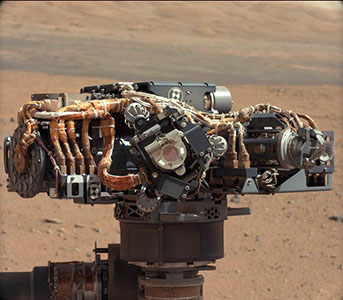
Originally published by RiAus on 18 June 2015.
Mars has been in the media a lot lately, whether it’s because there are plans to fly people there in the next 20 years, or because of the chance that it may be hospitable to humans, The Red Planet has gained a lot of attention. And so it should, it is a fascinating planet and the next frontier of space exploration. But, how do we know so much about this astonishing place? Answer: The Mars Rovers.
Like most people interested in science, or who watch the news, we’ve all heard of ‘The Mars Rover’. But, before today, the majority of my knowledge came from Howard in Big Bang Theory…apparently you can get it stuck in a ditch up there… needless to say, beyond the idea that there were ‘cars on Mars’, it was pretty difficult to understand what each them actually did and how. I didn’t even know that more than one had been sent into space!

There have been four Rovers sent to Mars by NASA; the Sojourner, Curiosity, Opportunity and Spirit. Each has contributed to our knowledge differently and given us an insight into the astonishing Red Planet. Thanks to these Rovers, we now know what it would be like to walk on Mars, more about the planet’s formation and how hospitable it is for future colonisation.
Sojourner
The Sojourner was one of the first Rovers to land on Mars in July 1997 (two Russian Rovers arrived first). It was covered in solar panels, so that it’s night time activities were severely limited. But, more importantly, Sojourner, had three cameras; two black-and-white cameras in the front, and a coloured camera at the back. It is these that sent us back the first images of Mars.
The Sojourner is also featured in the book that is soon to become a blockbuster, The Martian.
Spirit
No one has heard from Spirit since 2010. However, it did land on Mars in January 2004 and lasted over twenty times longer than scientists had predicted. It’s mission was supposed to go for 92 Earth days (90 Mars days or sols) and ended up functioning for 2695 Earth days (2623 sols).
Spirit collected samples from the surrounds to find out what the surface of Mars was made from. It used all of this information to:
- Find out whether there was water in the past (there was, which is what makes us think that Mars may be habitable)
- Geological history of the planet
- Gather data so that there is a measure of the accuracy of the orbiting instruments
- Find out if the surface of Mars is hospitable for people

Opportunity
Opportunity was the twin of Spirit and landed on The Red Planet three weeks later, in January 2014. But, unlike Spirit, Opportunity didn’t get bogged down in soft sand and is still sending information back to Earth. It has now spent 4160 Earth days (4049 sols) driving across the surface, collecting information.
Opportunity’s aims were the same as Spirit’s, but it has travelled over 40km (compared with the 7.73km covered by Spirit). Both Opportunity and Spirit have been sent images back to Earth as well as the meteorological data they collect.

Curiosity
Curiosity is the latest Rover to be sent to Mars, it landed in August 2012. Its goals include:
- Investigating the climate and geology of The Red Planet
- Find out if Gale Crater is favourable for microbial life
- nvestigate whether humans will really be able to live on Mars
In fact, Curiosity has eight goals, which can be separated into aims to investigate the biological, geological, planetary process and surface radiation. But the above are a really good overall idea.
Curiosity is going to be used as the basis for the next Rover to be sent to Mars in 2020. It is the largest Rover to be sent so far and has been able to gather some amazing information. The images throughout this article have also all been taken by Curiosity and have provided us with a window into what living on this planet would be like.

Simply doing research into these four Rovers has left me in awe of the amount of technology and data gathering equipment that can be attached to one vehicle. These amazing pieces of human ingenuity have allowed us to find out so much about a place that is ridiculously far from Earth. In other words, we know more about a place that is at least 225,300,000 km away than we do about the bottom of the ocean.

I like this post!
LikeLike